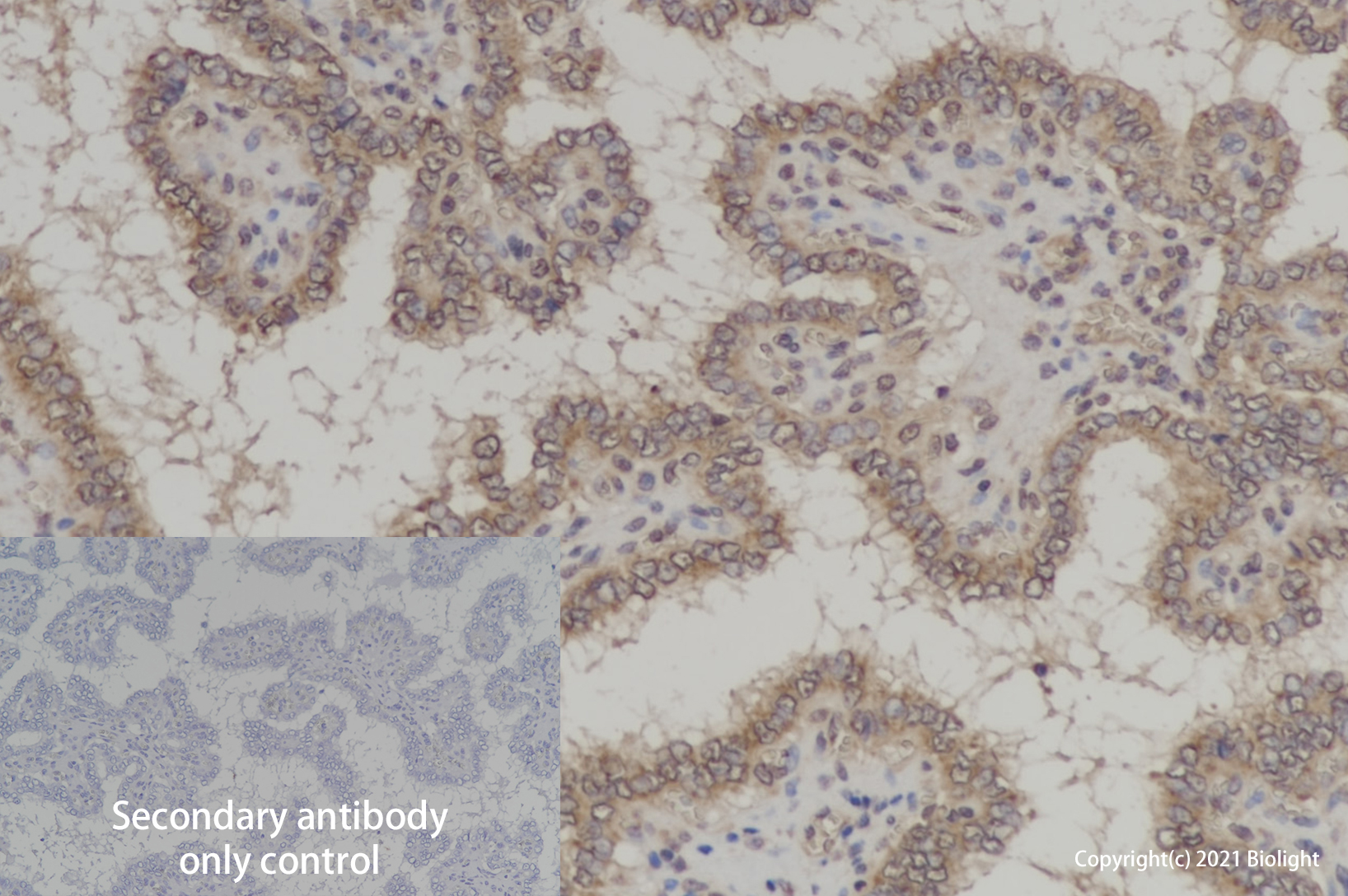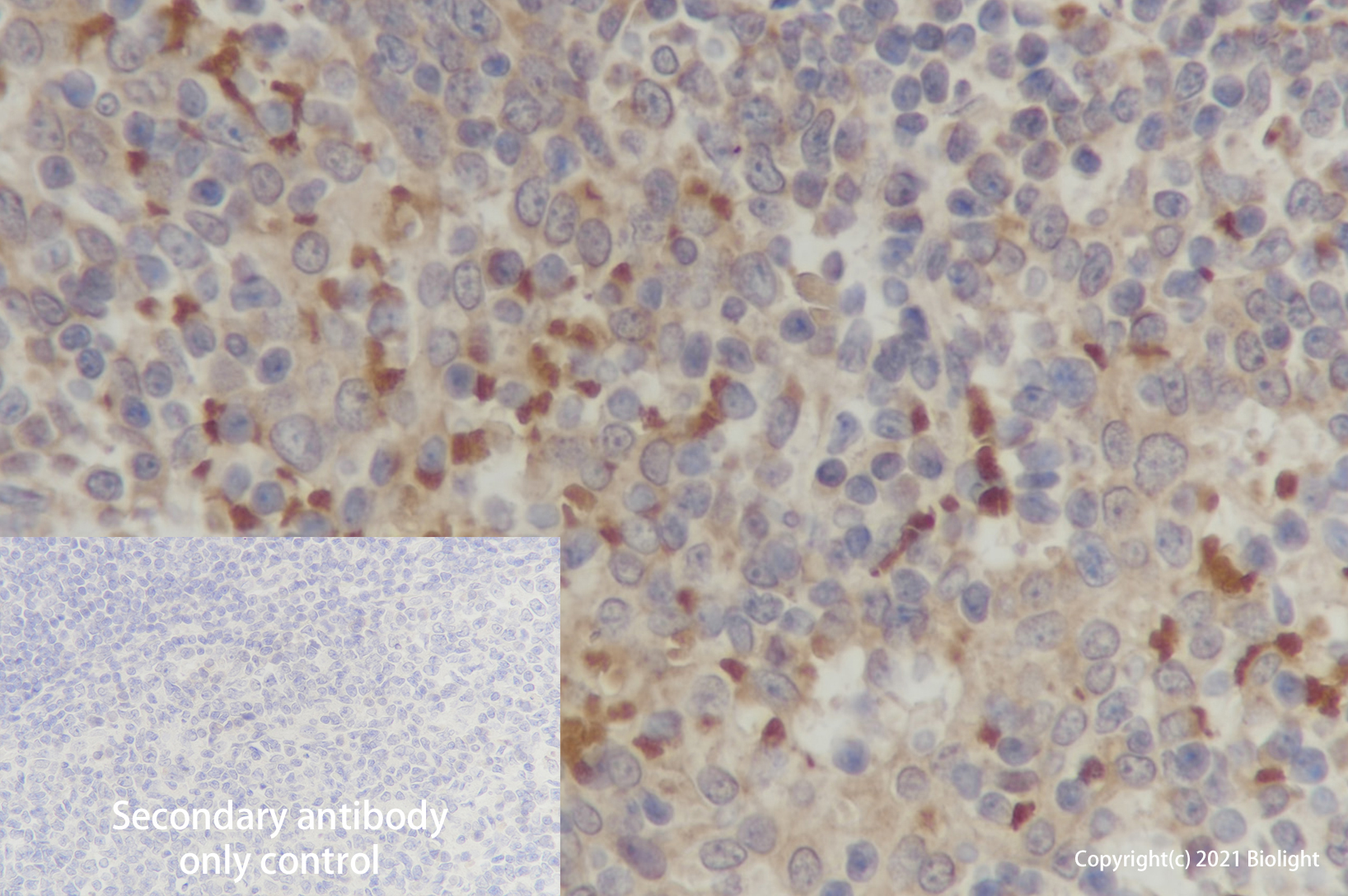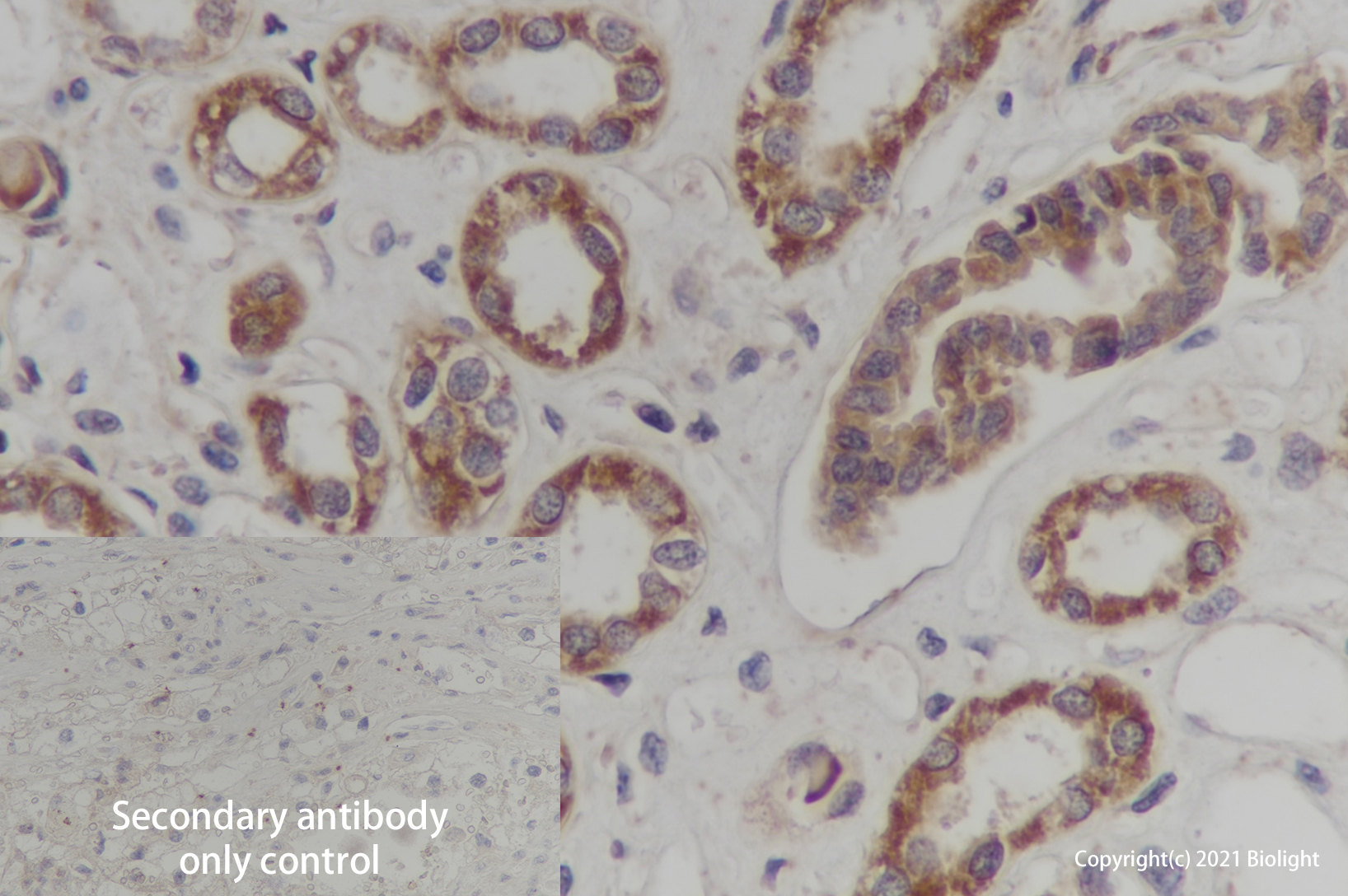
Anti-TNFRSF9 Antibody, Rabbit Polyclonal
产品编号:PA00774HuA10
$ 询价
规格 50uL 100uL 200uL
产品名称:Anti-TNFRSF9 Antibody, Rabbit Polyclonal
经验证的应用:WB
交叉反应:/
特异性:human TNFRSF9
免疫原:Recombinant human TNFRSF9 protein, fragment Leu24~His183; UniprotKB: Q07011
制备方法:Produced in rabbits immunized with human TNFRSF9, and purified by antigen affinity chromatography.
来源:Polyclonal Rabbit IgG
纯化:Immunogen affinity purified
缓冲液:Supplied in PBS, 50% glycerol and less than 0.02% sodium azide, PH7.4
偶联物:Unconjugated
状态:Liquid
运输方式:This antibody is shipped as liquid solution at ambient temperature. Upon receipt, store it immediately at the temperature recommended.
储存条件:This antibody can be stored at 2℃-8℃ for one month without detectable loss of activity. Antibody products are stable for twelve months from date of receipt when stored at -20℃ to -80℃. Preservative-Free. Avoid repeated freeze-thaw cycles.
图片:
Figure1.Immunohistochemistry (Formalin/PFA-fixed paraffin-embedded sections) analysis of human thyroid cancer sections labelling TNFRSF9 with purified PA00774HuA10 at 10ug/ml. Heat mediated antigen retrieval was performed using EDTA buffer (pH 9.0). Tissue was counterstained with Hematoxylin. Rabbit specific IHC polymer detection kit HRP/DAB secondary antibody was used at 1/4000 dilution. PBS instead of the primary antibody was used as the negative control.
Figure2.Immunohistochemistry (Formalin/PFA-fixed paraffin-embedded sections) analysis of human tonsil sections labelling TNFRSF9 with purified PA00774HuA10 at 10ug/ml. Heat mediated antigen retrieval was performed using EDTA buffer (pH 9.0). Tissue was counterstained with Hematoxylin. Rabbit specific IHC polymer detection kit HRP/DAB secondary antibody was used at 1/4000 dilution. PBS instead of the primary antibody was used as the negative control.
Figure3.Immunohistochemistry (Formalin/PFA-fixed paraffin-embedded sections) analysis of human kidney cancer sections labelling TNFRSF9 with purified PA00774HuA10 at 10ug/ml. Heat mediated antigen retrieval was performed using EDTA buffer (pH 9.0). Tissue was counterstained with Hematoxylin. Rabbit specific IHC polymer detection kit HRP/DAB secondary antibody was used at 1/4000 dilution. PBS instead of the primary antibody was used as the negative control.
别称:CD137, CDw137, 4-1BB, ILA, Induced By Lymphocyte Activation, T-cell antigen 4-1BB homolog
背景信息:4-1BB/TNFRSF9/CD137. 4-1BB, also known as CD137 and TNFRSF9, is an approximately 30 kDa transmembrane glycoprotein in the TNF receptor superfamily. 4-1BB functions in the development and activation of multiple immune cells (1). Mature human 4-1BB consists of a 163 amino acid (aa) extracellular domain (ECD) with four TNFR cysteine‑rich repeats, a 27 aa transmembrane segment, and a 42 aa cytoplasmic domain (2, 3). Within the ECD, human 4-1BB shares 60% aa sequence identity with mouse and rat 4-1BB. 4-1BB is expressed as a disulfide-linked homodimer on various populations of activated T cell including CD4+, CD8+, memory CD8+, NKT, and regulatory T cells (4-7) as well as on myeloid and mast cell progenitors, dendritic cells, mast cells, and bacterially infected osteoblasts (8-11). It binds with high affinity to the transmembrane 4-1BB Ligand/TNFSF9 which is expressed on antigen presenting cells and myeloid progenitor cells (3, 8). This interaction co‑stimulates the proliferation, activation, and/or survival of the 4-1BB expressing cell (3-7). It can also enhance the activation-induced cell death of repetitively stimulated T cells (3). Mice lacking 4-1BB show augmented T cell activation, perhaps due to its absence on regulatory T cells (12). 4-1BB can associate with OX40 on activated T cells, forming a complex that responds to either ligand and inhibits Treg and CD8+ T cell proliferation (13). Reverse signaling through 4-1BB Ligand inhibits the development of dendritic cells, B cells, and osteoclasts (8, 11) but supports mature dendritic cell survival and co‑stimulates the proliferation and activation of mast cells (9, 10).4‑1BB activation enhances CD8+ T cell and NK cell mediated anti-tumor immunity (14). It also contributes to the development of inflammation in high fat diet-induced metabolic syndrome (15). Soluble forms of 4-1BB and 4-1BB Ligand circulate at elevated levels in the serum of rheumatoid arthritis and hematologic cancer patients, respectively (16, 17).
全称:Tumor necrosis factor receptor superfamily member 9 (TNFRSF9)
说明书:待上传
背景信息:4-1BB/TNFRSF9/CD137. 4-1BB, also known as CD137 and TNFRSF9, is an approximately 30 kDa transmembrane glycoprotein in the TNF receptor superfamily. 4-1BB functions in the development and activation of multiple immune cells (1). Mature human 4-1BB consists of a 163 amino acid (aa) extracellular domain (ECD) with four TNFR cysteine‑rich repeats, a 27 aa transmembrane segment, and a 42 aa cytoplasmic domain (2, 3). Within the ECD, human 4-1BB shares 60% aa sequence identity with mouse and rat 4-1BB. 4-1BB is expressed as a disulfide-linked homodimer on various populations of activated T cell including CD4+, CD8+, memory CD8+, NKT, and regulatory T cells (4-7) as well as on myeloid and mast cell progenitors, dendritic cells, mast cells, and bacterially infected osteoblasts (8-11). It binds with high affinity to the transmembrane 4-1BB Ligand/TNFSF9 which is expressed on antigen presenting cells and myeloid progenitor cells (3, 8). This interaction co‑stimulates the proliferation, activation, and/or survival of the 4-1BB expressing cell (3-7). It can also enhance the activation-induced cell death of repetitively stimulated T cells (3). Mice lacking 4-1BB show augmented T cell activation, perhaps due to its absence on regulatory T cells (12). 4-1BB can associate with OX40 on activated T cells, forming a complex that responds to either ligand and inhibits Treg and CD8+ T cell proliferation (13). Reverse signaling through 4-1BB Ligand inhibits the development of dendritic cells, B cells, and osteoclasts (8, 11) but supports mature dendritic cell survival and co‑stimulates the proliferation and activation of mast cells (9, 10).4‑1BB activation enhances CD8+ T cell and NK cell mediated anti-tumor immunity (14). It also contributes to the development of inflammation in high fat diet-induced metabolic syndrome (15). Soluble forms of 4-1BB and 4-1BB Ligand circulate at elevated levels in the serum of rheumatoid arthritis and hematologic cancer patients, respectively (16, 17).
全称:Tumor necrosis factor receptor superfamily member 9 (TNFRSF9)
说明书:待上传



